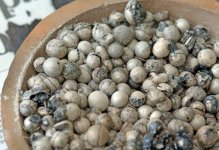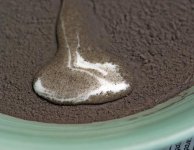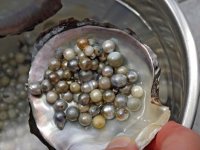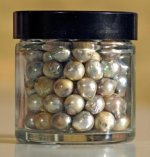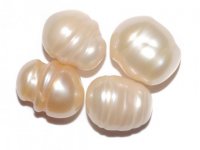Ayurveda and Rasa Shastra
Ayurveda and Rasa Shastra
Thank you Wendy for adding my pictures and asking the question, I am happy the community was able to shed a little more light on this aspect of the work. I have read the above comments with interest, its always good to get feedback from experts on these types of question. One branch of Ayurveda, known as Rasa Shastra considers the use of minerals, metals and gemstones to be excellent sources of medicine. Generally they are converted into bhasma (a type of alchemical ash) using a rather protracted series of heating techniques over a period of months, even years to produce a material fine enough to enter the body at a cellular level and deliver their healing potential. Pearls were considered to be a gemstone by the ancients due to their rarity, however modern bulk producers of these remedies don't have time to go pearl diving all day and so rely on cultured varieties.
I get asked to demonstrate how to reduce different types of material into what could be called their alchemical form (for want of a better word) and my question to Wendy was what she thought of the samples I got from a company in Okinawa. It seems the general census is: pretty poor. Of course the processing was just to demonstrate - not to end up with finished medicine. But now I have this wonderful resource to call upon, perhaps someone might have some thoughts on what Ayurvedic texts say about Mukta (pearls).
It seems the oceanic variety were considered superior to their freshwater cousins. I would imagine that the nacre was the active ingredient and so just wanted to clarify if the natural ocean pearls would have a greater or lesser amount of nacre on them as opposed to the natural freshwater ones?I think its an interesting question?
To answer one question posted about possible health issues /contamination. The heating process used in these remedies can be in excess of 800c so no problems, also if M.O.P (which is also a medicine in Rasa Shastra called Sukti) is used to create the bead/nucleolus (did I get that right?), it’s also has accepted medicinal qualities and so no problem to have it included in the material. Due to the processing of many alchemical remedies its almost impossible not to have some level of contamination present, even the best samples often have variations and hidden elements present. Interestingly all these materials (of animal origin) have different properties, cowrie shell is quite different in its action to pearl (one is heating the other cooling). Even though they are both essentially calcium carbonates they have different effects on the body.
I had an XRD analysis done on the finished bhasma of pearl and found it to be comprised mostly of: calcium, potassium, carbon with trace elements of sodium, phosphorus and sulphur -so all in all - quite a bag of goodies!
I would also like to know if anyone has come across types of pearl and knows anything of their compositions. Ayurveda says there are nine types - these include snake, boar, conch, elephant, bamboo, whale, fish, oyster and cloud (the last one has me beat I must admit). I found some images on the net, but not much useful data. I expect the team knows something of these things, I would be very interested to hear anyone's comments.
I attach a picture of my (poor) Akoya pearls during their processing.
Thanks for your time on these questions, I understand their are probably a bit weird - but it’s an odd world out there and someone has to do this work........ha
Andrew
image 1 shows pearls after a single heating session
image 2 shows pearls after 3 heating sessions, being mixed with raw milk.
